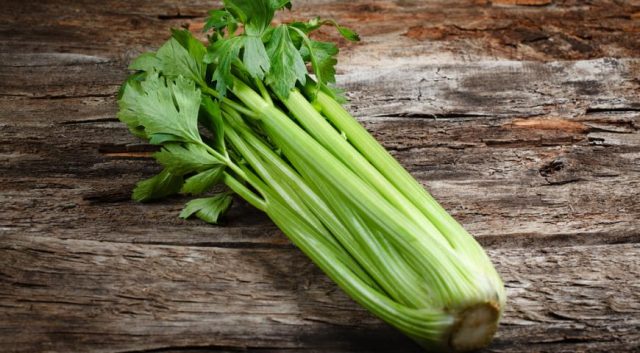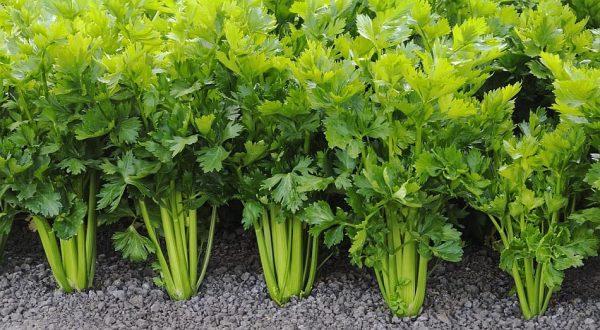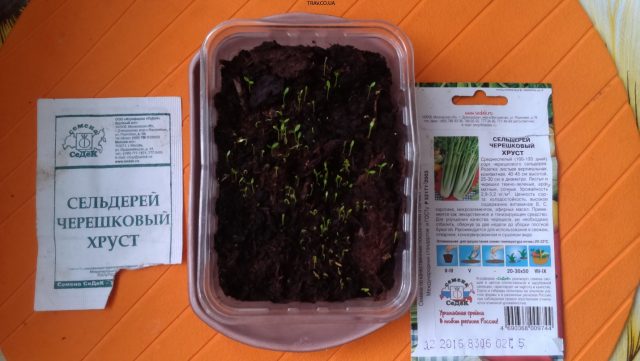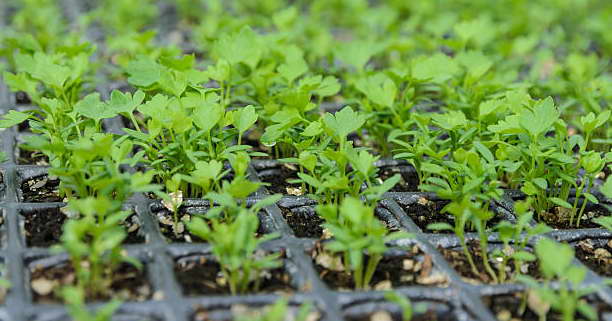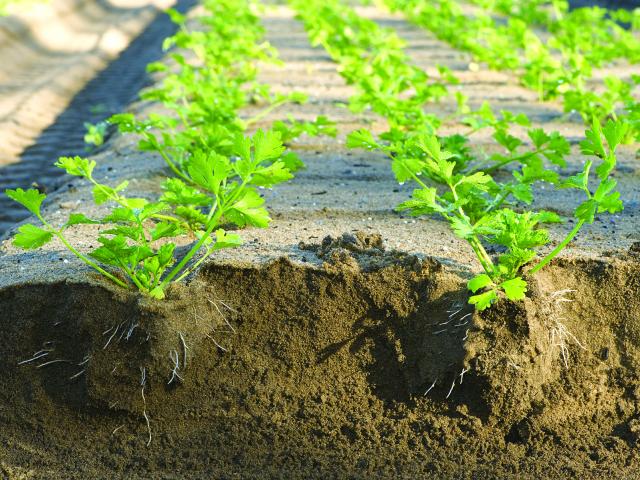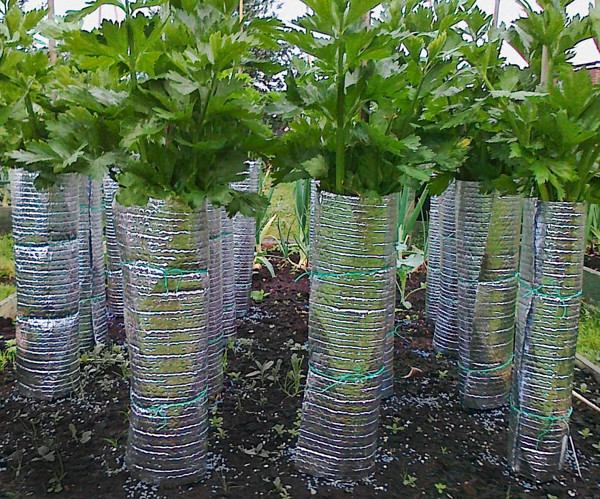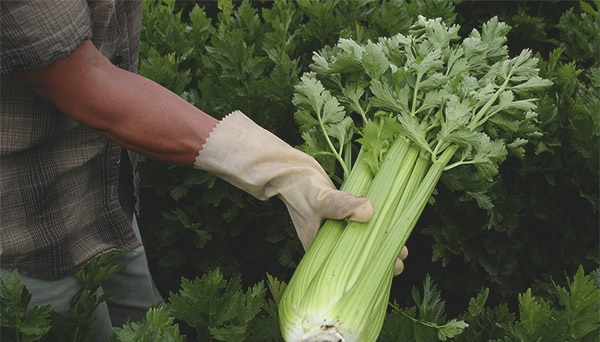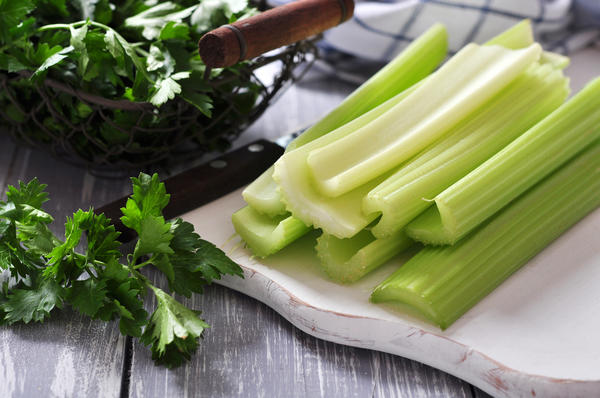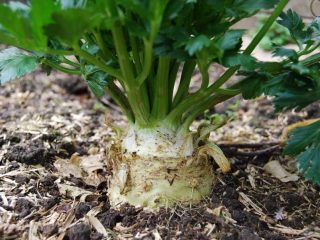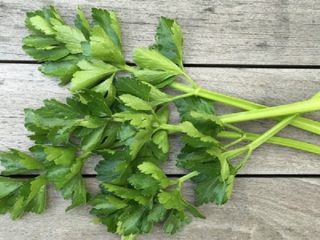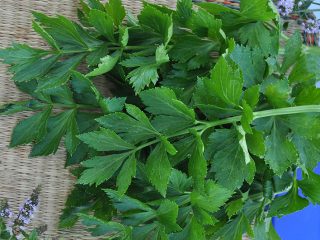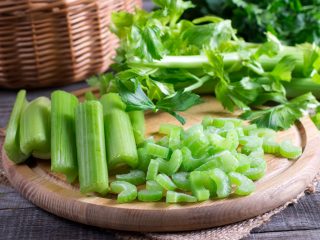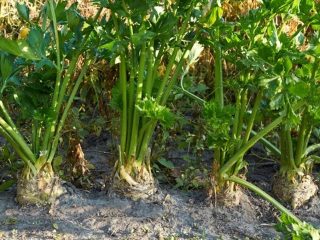Content
- 1 Petiole celery - perennial or annual
- 2 How does celery grow?
- 3 How to grow petiole celery from seeds to seedlings
- 4 How to plant petiole celery in open ground
- 5 How to care for petiole celery in open ground
- 6 How to bleach petiole celery
- 7 Harvesting
- 8 Reproduction
- 9 Pests and diseases of petiole celery
- 10 What to do with stem celery for the winter
- 11 Conclusion
Celery Odorous or Fragrant is a type of herbaceous plant belonging to the genus Celery from the Apiaceae family. It is a food and medicinal crop and can be root, leaf or petiole. Botanically, the varieties are very similar to each other, but the way they are grown differs. Caring for petiole celery in open ground is easier than caring for root celery, but growing leaf celery takes more time.
Petiole celery - perennial or annual
Scented Celery is a plant with a two-year life cycle. In the first year, it forms a dense root crop without voids inside and a large rosette of leaves on large petioles.On the second, it produces a peduncle up to 1 m high and sets seeds. Harvesting of roots, petioles and spicy leaves is carried out in the year of planting, and the next year they receive their own planting material.
Celery was previously grown as a medicinal plant, but now its healing properties have faded into the background, the crop is recognized as a vegetable and is used in the cuisines of different nations. In the post-Soviet space, root vegetables have become most popular, while in Europe petiole varieties are usually purchased.
Stem celery has a fibrous root system and forms a small root crop that is difficult to distinguish under numerous lateral branches. It grows a large rosette, the larger volume of which is occupied not by leaves, but by petioles. Their color can be green, light green, pink or reddish, width - from 2 to 4 cm with a thickness of no more than 1 cm. In classical varieties, the stems are bleached before harvesting (deprived of light) to remove bitterness and make them tender, many modern ones they don't need it.
Typically, each leaf rosette consists of 15-20 erect leaves. But there are varieties that produce up to 40 branches, sometimes semi-spreading. The stems are wide at the bottom, narrow at the ends and end in triangular, pinnately dissected dark green leaves. The petioles are hollow inside, ribbed, with a pronounced groove on the part facing the center of the rosette. Their length depends not only on the variety, but also on the agricultural technology of stem celery, and ranges from 22 to 50 cm.
Seeds are small achenes that remain viable for no more than 4 years (guaranteed 1-2 years).A peduncle about a meter long appears in the second year of life.
How does celery grow?
Celery is a moisture-loving crop that tolerates short-term temperature drops well. The seedlings can withstand frost of -5° C, although not for long. The most cold-resistant varieties are those with red petioles.
Leaf celery has the shortest growing season and can be sown directly into the ground. It will take about 200 days for the root crop to form. It is grown exclusively through seedlings, and in the North-West it is rarely planted in open ground.
Petiole celery occupies an intermediate position - from the moment of sprouting to harvesting, 80-180 days pass for different varieties. To obtain marketable stems, seeds can be sown in the ground, but it is more rational to first grow seedlings.
The optimal temperature for growing vegetable celery is 12-20° C. And although it tolerates temporary cold weather well, if the thermometer does not reach 10° C for a long time, premature bolting may begin.
How to grow petiole celery from seeds to seedlings
There is nothing difficult about growing celery seedlings. Its seedlings are much hardier than those of tomatoes or peppers, and these crops are grown and planted by millions of gardeners every year.
Landing dates
Petiole celery seeds are sown for seedlings from late February to mid-March. Most varieties have a fairly long growing season, and the stems must have time to acquire a marketable appearance before the cold weather. First, the root and leaves develop, the petioles grow in length, and only then they increase in mass. This takes a lot of time, although not as much as for the formation of a root crop.
Preparing the container and soil
Celery seeds can be sown in ordinary wooden seedling boxes or directly into separate plastic cups with holes for water drainage.
Containers that have already been used are washed well with a brush, rinsed and soaked in a strong solution of potassium permanganate. This will kill most of the germs and bacteria that can cause disease in seedlings.
To grow petiole celery from seeds, you can take regular purchased soil for seedlings. You can prepare the substrate yourself by mixing equal parts of garden soil and well-rotted humus with the addition of sand. Only it needs to be sifted through a sieve to remove all lumps, pebbles and plant debris - the soil for seedlings must be homogeneous and permeable to water and air.
Seed preparation
Celery seeds are very small - 1 g contains about 800 pieces. In addition, they quickly lose their viability. So, planting material collected by yourself should be used as early as possible, and in the store you should pay attention to the expiration date.
The seeds of umbrella crops take a long time to germinate - this is due to the presence of essential oils in them. That is why in the southern regions crops such as carrots are sown dry for the winter and there is no fear that they will germinate at the wrong time.
Without preparation, celery seeds will take more than 20 days to hatch, and the seedlings will be uneven and weak. There are many ways to speed up their germination and improve the quality of seedlings, here is one of them:
- The seeds are soaked for 3 days in warm water, which is changed twice a day.
- Place a piece of white cloth in a shallow, wide container. The swollen seeds are spread on it in a thin layer and moistened with water.
- The container is kept at room temperature for 7-10 days, not forgetting to moisten the fabric.
During this time, the seeds should hatch - this will be clearly visible on the white fabric. They need to be planted immediately.
To make celery seeds germinate faster, the following methods are often used:
- soaking in special preparations sold in seed stores;
- soaking in hot water (no more than 60°) for 30 minutes.
Planting petiole celery for seedlings
Seeds can be sown not only in planting boxes filled with moist substrate for seedlings, but also in greenhouses. The soil is compacted, shallow furrows are made at a distance of 5-8 cm from each other. Seeds are placed in them at the rate of 0.5 g per 1 square meter. m and sprayed with a household spray bottle.
If the planting material was not germinated, but soaked in hot water or a stimulant, you can do something simpler. A thin layer of snow is placed in the prepared box, leveled, furrows are drawn and seeds are sown in them. Then they will definitely not be washed out and fall into the ground during watering.
Sowing can be done in separate cups with several seeds in each. Then you won’t have to pick them, you just need to cut off the weak shoots with nail scissors, leaving the strongest ones.
Containers with seeds are covered with glass or transparent film and placed on a light windowsill or illuminated shelves. The shelter is removed after germination.
Caring for petiole celery seedlings
When the stalked celery seeds hatch, place the containers for a week in a bright room with a temperature of 10-12° C - this will prevent the seedlings from stretching. Then the seedlings are transferred to a warmer place, providing fresh air and good lighting.
You need to moisten petiole celery carefully - boxes from a household spray bottle, and cups - with a teaspoon, from which water is poured not onto the ground, but along the walls.
In the phase of 2-3 non-standing leaves, seedlings are planted in separate cups with a bottom hole or special cassettes. In this case, the sprouts of petiole celery are buried in the soil up to the cotyledon leaves, and the root, if it has stretched more than 6-7 cm, is shortened by 1/3.
The ideal temperature for seedlings of petiole celery is 16-20 ° C. During the day it should not exceed 25 ° C, at night - 18 ° C. For seedlings located on a loggia or veranda, a temperature of 5 ° C is considered unacceptable. It stops growing and with great there is a possibility of getting sick with blackleg or going to bed. The room should have a relative humidity of 60-70% and good air ventilation.
The soil should be constantly moist, but not wet. 10-15 days before planting, seedlings are fed with a complete complex fertilizer, diluted 2 times more than recommended in the instructions.
How to plant petiole celery in open ground
About two months after emergence, celery seedlings are ready to be transplanted into the ground.By this time it should have at least 4-5 true leaves.
Landing dates
Seedlings of petiole celery are planted in the soil of a cabbage field, depending on the region - at the end of May or beginning of June. Even if the temperature drops at this time, it’s not scary. Celery can withstand cold well, the main thing is that the seedlings have time to take root and sprout a new leaf. In the southern regions, petiole celery can be planted in open ground earlier.
Preparing the landing site and soil
You can grow petiole celery in the garden after potatoes, cabbage, beets, cucumbers, zucchini, tomatoes, and pumpkins. Before planting the seedlings, the garden beds have time to harvest early radishes, spinach or lettuce.
Petiole celery prefers loose, fertile soils with a neutral reaction. The bed is dug up in the fall using a spade. For each square meter, add at least 4-5 kg of rotted manure. In the spring, before planting seedlings, shallow loosening is carried out and special fertilizers for root crops are added according to the instructions, or a glass of ash and a tablespoon of double superphosphate per square meter.
Acidic soils are brought back to normal by adding lime or dolomite flour, and it is better to do this in the fall, and not before planting celery. Dense soils will already be improved by humus, but if necessary, you can add sand - for spring loosening or directly into each hole when planting.
When growing petiole celery in the country, you need to choose a flat, well-lit area. In areas prone to soaking, ridges are created - although the crop is moisture-loving, it does not tolerate waterlogging, much less stagnation of water.
Preparation of planting material
Petiole celery intended for cultivation in open ground needs hardening. About a week before the scheduled date, the cups are placed in boxes and taken outside during the day. At night, five of them are removed into the room. 2 days before planting, seedlings are stopped brought into the house, leaving them outside around the clock.
On the eve of transfer to open ground, water the celery, but not abundantly, but so that the earthen lump is slightly moist.
Planting petiole celery in the ground
Growing and caring for petiole celery begins with transplanting into open ground. In order for the crop to produce a good harvest, the plants must be placed freely and exposed to the sun all day. Petiole celery seedlings are planted in beds in rows spaced 40-70 cm apart. The distance between bushes should be at least 40-50 cm.
Some gardeners practice growing stem celery in shallow trenches. This is partly justified - it will be easier to shade it when the time comes to bleach the petioles. But the bushes must receive enough sun, therefore, the trenches must be wide and directed from south to north. Otherwise there will be nothing to bleach.
The seedlings are planted a little deeper than they were growing in cups or cassettes, but so that the growth point remains on the surface of the soil. You need to make sure that it is not covered with soil.
Planted petiole celery seedlings are watered abundantly. There is no need to mulch the bed - it will have to be loosened frequently.
How to care for petiole celery in open ground
If a strong cold snap is expected or the stalked celery seedlings have not had time to take root, the bed is covered with agrofibre or lutrasteel.At night you can replace them with newspapers, only the edges need to be secured so that the wind does not blow them away.
How to water
When growing and caring for stem celery, one of the main agrotechnical measures is watering. Without this, no bleaching can remove the bitterness from the petioles, and they will not reach a decent size.
Celery is a moisture-loving crop. It needs to be watered often and in large quantities. If the soil is as recommended - permeable to air and moisture, there should be no stagnation of water and diseases associated with it. After each watering or rain, the row spacing is loosened.
How to feed
It is unrealistic to grow high-quality stem celery without frequent fertilizing. The first time it is fertilized with a complete mineral complex 15-20 days after planting the seedlings. In the future, fertilizing is given weekly after watering. If you use chemistry for this, not a healthy, tasty plant will grow, but something that is impossible to eat without harm to health.
Therefore, after the first mineral fertilizing, celery is fertilized with an infusion of herbs, diluted with water in a ratio of 1:3 every week. Twice a month, add a tablespoon of superphosphate to a bucket of water. At least a liter of solution is poured onto one bush.
How to bleach petiole celery
Bleaching petiole celery in open ground is an operation designed to block the access of light to the stems. It helps remove bitterness and make the product more tender.If you neglect bleaching, the petioles will be tough and taste the same as the leaves.
To bleach celery, the easiest way is to cover it with soil as soon as it reaches a height of 30 cm. Only the leaves should remain in the light. The procedure is repeated every two weeks.
Many people don't bother growing stem celery because they don't want to cover it with soil. Gardeners know that soil needs to be washed out from the axil of each petiole individually; this takes a lot of time. But you can bleach celery stalks in other ways:
- place boards or plywood on both sides of the row;
- wrap the bushes in dark cloth, thick paper or several layers of newspaper, and tie with an elastic band;
- use completely rotted sawdust or sawdust for hilling;
- cover the rows with nut shells and tree bark, if they are available in sufficient quantities.
Before bleaching celery stalks, you need to tear off all the thin stalks growing on the outside of the bush. The leaves must remain free - if you block their access to light, the plant will stop developing and may deteriorate. There should be no gap between the soil surface and the material covering the petioles.
You cannot use fresh wood residues - tyrsa or sawdust, fallen leaves, straw - to bleach stems. Celery will be watered abundantly while it is in the ground, these materials will begin to rot and generate heat, and this is unacceptable.
Harvesting
Varieties of petiole celery are ready for harvest at different times.Usually the self-bleaching ones ripen first. Rosettes intended for long-term fresh storage must be removed from the garden bed before frost sets in. Celery that has been exposed to subzero temperatures is suitable for food, but does not taste good.
Classic varieties with white petioles are stored best and longest. The bushes are carefully dug up by the roots, transferred to a cellar or basement, and buried in wet sand or peat. At a temperature of 4 to 6 ° C and a humidity of 85-90%, petiole celery will not only be stored all winter, but will also sprout new leaves.
Reproduction
Celery reproduces by seeds. The best plants are selected as mother plants, carefully dug up before frost sets in, the leaves are cut into a cone, and stored in plastic bags in a cellar or basement.
In the second year, celery root is planted in a garden bed to obtain seeds. First, sparse greenery appears, then high, up to 1 m arrow. Flowering occurs 2 months after planting the root crop, and lasts about three weeks.
From the moment the celery mother plant is planted until the seeds are collected, 140-150 days should pass, by which time they should change color from green to greenish-violet. The seeds are ripened under a canopy or in a ventilated area and threshed.
In the Northwest they may not have enough time to mature in the ground.It is recommended to pinch the top of the flower shoot when enough seeds have formed on it - each plant can produce 20-30 g of seeds. This is more than enough to provide yourself, neighbors and friends with planting material.
Pests and diseases of petiole celery
Leaf and petiole celery, due to the high content of essential oils, rarely gets sick and is moderately affected by pests. The greatest danger to the crop is overflow and stagnation of water in the root area; they are the main cause of rot. Most often they affect the growing point and stem.
Other diseases of petiole celery include:
- bacterial leaf spot;
- black leg;
- viral mosaic.
Pests that attack celery:
- slugs and snails;
- scoops;
- carrot flies.
Proper agricultural practices will help prevent diseases and pests:
- careful selection of landing site;
- crop rotation;
- pre-planting soil preparation;
- timely loosening of the soil and weeding weed;
- proper watering;
- if necessary, thinning of crops.
What to do with stem celery for the winter
You can store fresh stalked celery for up to three months in a ventilated basement or cellar at a temperature of 4-6 ° C and a humidity of 85-90%. Washed and placed in plastic bags, it can remain in the vegetable section of the refrigerator for up to 30 days. The stem pieces will keep for about a year in the freezer.
Petiole celery can be cut into pieces and dried. Its taste will be very different from fresh or frozen. Salads are prepared with celery, it is salted, the juice is squeezed and frozen.
Conclusion
Caring for petiole celery in open ground can hardly be called burdensome. But by planting the crop themselves, gardeners can control the growing conditions and feed it with organic fertilizers. This is the only way to guarantee that a tasty and healthy product will be on the table, and not a set of chemical elements.
